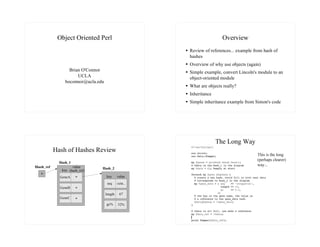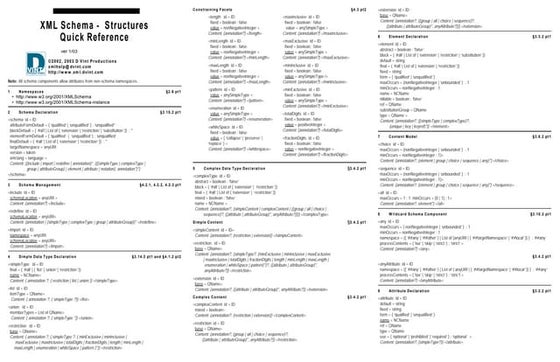perl_objects
- 1. Object Oriented Perl Overview Review of references... example from hash of hashes Overview of why use objects (again) Brian O'Connor Simple example, convert Lincoln's module to an UCLA object-oriented module boconnor@ucla.edu What are objects really? Inheritance Simple inheritance example from Simon's code The Long Way Hash of Hashes Review This is the long (perhaps clearer) Hash_1 $hash_ref value way... key (hash_ref) Hash_2 * GeneA * key value seq ccta... GeneB * length 67 GeneC * gc% 52%
- 2. The Long Way If we dump $data, which is a hashref, we get Hash of Hashes Review the following: $VAR1 = { Hash_1 'GeneC' => { $hash_ref value 'length' => 10, key (hash_ref) Hash_2 'gc' => '0.5', * 'seq' => 'cccggattat' GeneA * key value }, 'GeneB' => { seq ccta... 'length' => 10, 'gc' => '0.5', GeneB * 'seq' => 'cccggattat' length 67 }, 'GeneA' => { GeneC * 'length' => 10, gc% 52% 'gc' => '0.5', 'seq' => 'cccggattat' } }; The Short Way The Short Way Compare that with the way I showed you You can see the structure produced is the same: yesterday: $VAR1 = { 'GeneC' => { 'length' => 10, 'gc' => '0.5', 'seq' => 'cccggattat' }, 'GeneB' => { 'length' => 10, 'gc' => '0.5', 'seq' => 'cccggattat' }, 'GeneA' => { 'length' => 10, 'gc' => '0.5', 'seq' => 'cccggattat' } };
- 3. Why Objects Why Object Oriented Perl? Small App Small App Small App MONOLITHIC vs. Obj 1 Obj 3 Obj 1 Obj 3 Obj 2 Small App Obj 2 Look Inside an Object Modules vs. Objects First, let's convert Lincoln's MySequence module Obj1 from an earlier lecture to an object-oriented module method_1 The difference is pretty clear: Data method_2 modules let you import variables and subroutines into your current program when you say ˇ°useˇ± method_3 objects are encapsulated, you get a reference to one (usually using ˇ°newˇ±) and call methods on them directly
- 4. The Original Module Code to Call MySequence the subroutines in this module are now available in your code Exporter What we export Works as You Expect Conflicts By saying use MySequence; all the subroutines What happens when you have conflicts for and data MySequence exports is available within subroutines or variables? your program [boconnor@dhcp10-51 module]$ perl test.pl original = gattccggatttccaaagggttcccaatttggg complement = cccaaattgggaaccctttggaaatccggaatc
- 5. Conflicts The Object Oriented Way What happens when you have conflicts for subroutines or variables? Let's recode this as an object-oriented module [boconnor@dhcp10-51 module]$ perl test.pl Avoids pollution of your namespace HI!! Key terms original = gattccggatttccaaagggttcccaatttggg complement = 1 abstraction encapsulation The new subroutine interferes with the MySequence subroutine Recall from Yesterday Recall from Yesterday How to create an object from an Object Oriented How to then call methods on that object... Module... #!/usr/bin/perl -w $sequence->subseq(1,40); use strict; $sequence->id(); use Bio::PrimarySeq; $sequence->desc(); my $sequence = Bio::PrimarySeq->new( -seq => 'gattaca', -id => 'oligo234', -alphabet => 'dna' );
- 6. The Original Module The Object Oriented Module Need to When you make a method call on an OO Module the eliminate the first argument is the class Exporter code Need to include a ˇ°newˇ± method The Object Oriented Module The Object Oriented Module You create a new hash bless associates this new reference ($self) and this bit of memory with a class will store all the objects type (i.e. package to call data methods with)
- 7. What Does bless Mean? What Does bless Mean? an example... in the debugger an example... $obj = { name => 'mini', color => $obj = { name => 'mini', color => 'yellow' }; 'yellow' }; x $obj print ref($obj), ˇ° ˇ±, $obj->{name}, ˇ°nˇ±; bless ($obj, ˇ°Fruit::Bananaˇ±); Fruit::Banana=HASH(0x8ec7980) print ref($obj), ˇ° ˇ±, $obj->{name}, ˇ°nˇ±; 'color' => 'yellow' 'name' => 'mini' HASH mini Fruit::Banana mini What is an object then? A hashref that stores data and is associated with a package The Object Oriented Module The Object Oriented Module The object is now created and returned to the program that called new. When called in an object context the object is automatically passed in at the first argument
- 8. What is $self? Code to Call MySequence the actual object you're calling this method from Let's take a look at the code that uses the new OO allows you to manipulate the data within that MySequence module specific object instance (it's just a hashref) compare this to new() and other method calls like it Output is Identical! Why Object Oriented Perl? Identical output to the previous version Small App [boconnor@dhcp10-51 oo_module]$ perl test.pl Small App original = gattccggatttccaaagggttcccaatttggg complement = cccaaattgggaaccctttggaaatccggaatc Obj 1 Obj 3 And you can create your own reversec subroutine log log and not have it conflict with the MySequence Obj 2 Small App method! log
- 9. Inheritance Inheritance In this example every object has a log() method Independent parent Base & Redundant log Wouldn't it be nice to only write this once? becomes Solution: Inheritance! Obj 1 log child Obj 1 Obj 2 Obj 2 log Neither actually implements a log method More Generally Simon's Example: The Machines! Let's take a look at the implementation of the superclass Fruit name, color, shape following hierarchy isa isa Machine voltage name, color, shape, subclass Grape Banana peel isa isa Think of Banana inherits voltage voltage Refrigerator ATM inheritance as an name, color & temp cash ˇ°isaˇ± relationship shape banana adds peel
- 10. Simon's Example: The Machines! Simon's Example: The Machines! We want to implement Machine and Refrigerator The means that we can create a Refrigerator so that Machine defines the voltage() method object and call either voltage() or temp() and Refrigerator defines the temp() method on it Machine voltage Machine voltage isa isa isa isa voltage voltage voltage voltage Refrigerator ATM Refrigerator ATM temp cash temp cash Let's Start with test.pl Let's Start with test.pl ˇ°useˇ± what you want Always include a method to to create before you create a new object. call new Call it using this OOP syntax. * differs from calling Machine::Refrigerator::new()
- 11. The Refrigerator The Refrigerator Recall, the Refrigerator needs to do 2 things for magic the client: get/set a temperature get/set a voltage magic The Refrigerator The Refrigerator This says, use the Machine, as the root ˇ°Machineˇ± module class, handles the as a base class. creation and Everything a initialization of the Machine can do so object via its new can a Refrigerator. method. This is how you call it.
- 12. The Machine The Refrigerator Call new() to Create a Refrigerator magic It returns a new object of type Machine::Refrigerator!! magic The Machine The Machine Call new() to Create a Refrigerator Call new() to Create a Refrigerator so the object ($self) is just a reference to an empty hash! Just like in the How does it become a MySequence example, Machine::Refrigerator? the bless command associates a hashref with a class (Machine::Refrigerator in this case)
- 13. The Refrigerator Finish back at test.pl $r (a Machine::Refrigerator) has both the voltage() method (from Machine) and it's Finish setting up own temp() method Refrigerator specific information and return the new object $self Look at the Output Lessons You can call both temp() and voltage() on When you call a method this way: the $r object which is of type Machine::Refrigerator->new( Machine::Refrigerator temp => 20, voltage => 110 ); my $self = $class->SUPER::new(@_); [boconnor@dhcp10-51]$ perl test.pl Start temp: 20 Start voltage: 110 The first var is a string of the class (package) New temp: 45 name you're calling on... In both cases it's ˇ°Machine::Refrigeratorˇ±
- 14. Lessons Lessons When you call a method this way (through an The returned object is a bit of memory (a hashref) object): associated with a given class and it's methods $r->temp(); Here's a dump in the debugger of the $r object: The first var is a reference to the object itself so you can get/set data within it... it's just a ˇ°blessedˇ± hashref! DB<2> x $r Machine::Refrigerator=HASH(0x94e3bd8) sub temp { 'temp' => 20 my $self = shift; 'voltage' => 110 ... } So Now You... For More Information Can use references Perl Cookbook, Programming Perl Can use other people's objects perlobj and perlref man pages Can create objects of your own Google Can create complex object trees through Simon's Object Tutorial, try implementing the inheritance ATM class



![The Original Module Code to Call MySequence
the subroutines in this module are now available
in your code
Exporter
What we
export
Works as You Expect Conflicts
By saying use MySequence; all the subroutines What happens when you have conflicts for
and data MySequence exports is available within subroutines or variables?
your program
[boconnor@dhcp10-51 module]$ perl test.pl
original = gattccggatttccaaagggttcccaatttggg
complement = cccaaattgggaaccctttggaaatccggaatc](https://image.slidesharecdn.com/2620603/85/perl_objects-4-320.jpg)
![Conflicts
The Object Oriented Way
What happens when you have conflicts for
subroutines or variables?
Let's recode this as an object-oriented module
[boconnor@dhcp10-51 module]$ perl test.pl
Avoids pollution of your namespace
HI!! Key terms
original = gattccggatttccaaagggttcccaatttggg
complement = 1 abstraction
encapsulation
The new subroutine interferes with the
MySequence subroutine
Recall from Yesterday Recall from Yesterday
How to create an object from an Object Oriented How to then call methods on that object...
Module...
#!/usr/bin/perl -w $sequence->subseq(1,40);
use strict; $sequence->id();
use Bio::PrimarySeq; $sequence->desc();
my $sequence = Bio::PrimarySeq->new(
-seq => 'gattaca',
-id => 'oligo234',
-alphabet => 'dna'
);](https://image.slidesharecdn.com/2620603/85/perl_objects-5-320.jpg)


![What is $self? Code to Call MySequence
the actual object you're calling this method from Let's take a look at the code that uses the new OO
allows you to manipulate the data within that MySequence module
specific object instance (it's just a hashref)
compare this to new() and other method calls
like it
Output is Identical! Why Object Oriented Perl?
Identical output to the previous version
Small App
[boconnor@dhcp10-51 oo_module]$ perl test.pl Small App
original = gattccggatttccaaagggttcccaatttggg
complement = cccaaattgggaaccctttggaaatccggaatc
Obj 1 Obj 3
And you can create your own reversec subroutine log log
and not have it conflict with the MySequence Obj 2
Small App
method! log](https://image.slidesharecdn.com/2620603/85/perl_objects-8-320.jpg)




![The Refrigerator Finish back at test.pl
$r (a Machine::Refrigerator)
has both the voltage()
method (from Machine) and it's
Finish setting up own temp() method
Refrigerator
specific information
and return the new
object $self
Look at the Output Lessons
You can call both temp() and voltage() on When you call a method this way:
the $r object which is of type
Machine::Refrigerator->new(
Machine::Refrigerator temp => 20,
voltage => 110 );
my $self = $class->SUPER::new(@_);
[boconnor@dhcp10-51]$ perl test.pl
Start temp: 20
Start voltage: 110 The first var is a string of the class (package)
New temp: 45 name you're calling on... In both cases it's
ˇ°Machine::Refrigeratorˇ±](https://image.slidesharecdn.com/2620603/85/perl_objects-13-320.jpg)





































![Fast Screen Recorder v2.1.0.11 Crack Updated [April-2025]](https://cdn.slidesharecdn.com/ss_thumbnails/dataanalysisforbusiness-250322061148-eeff8a831-250401123246-f36be9ca-250401141614-87b01766-thumbnail.jpg?width=560&fit=bounds)

















